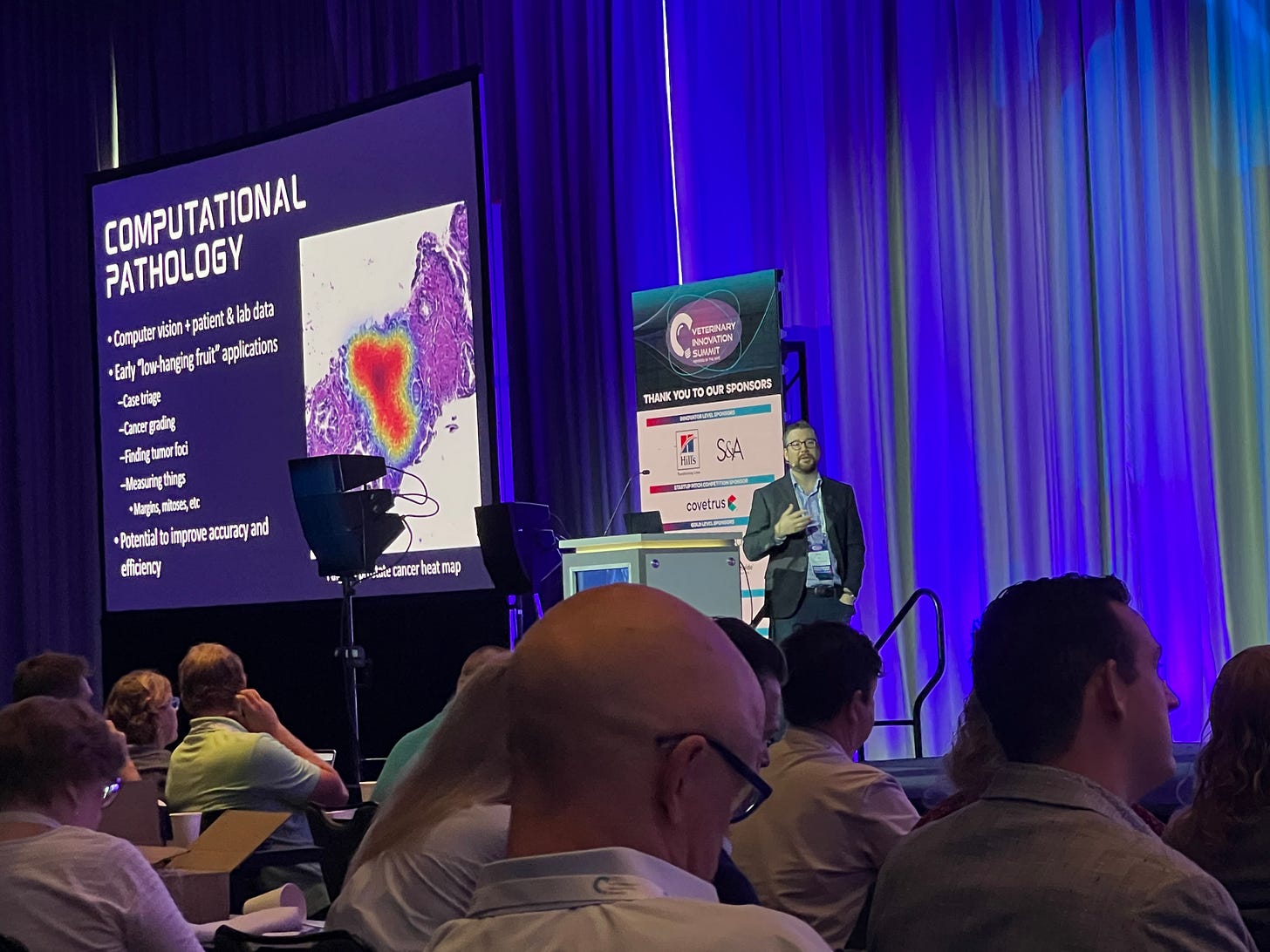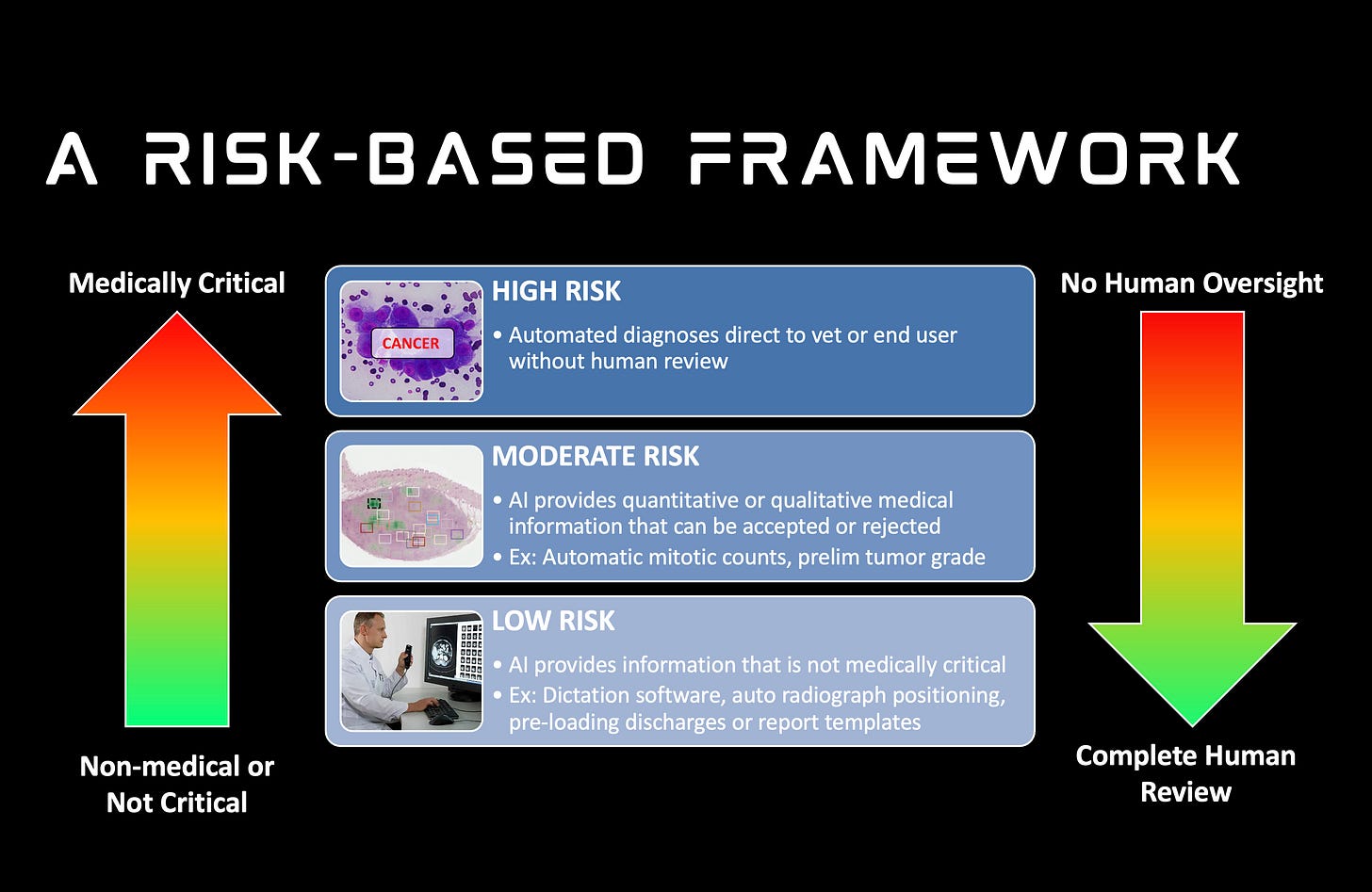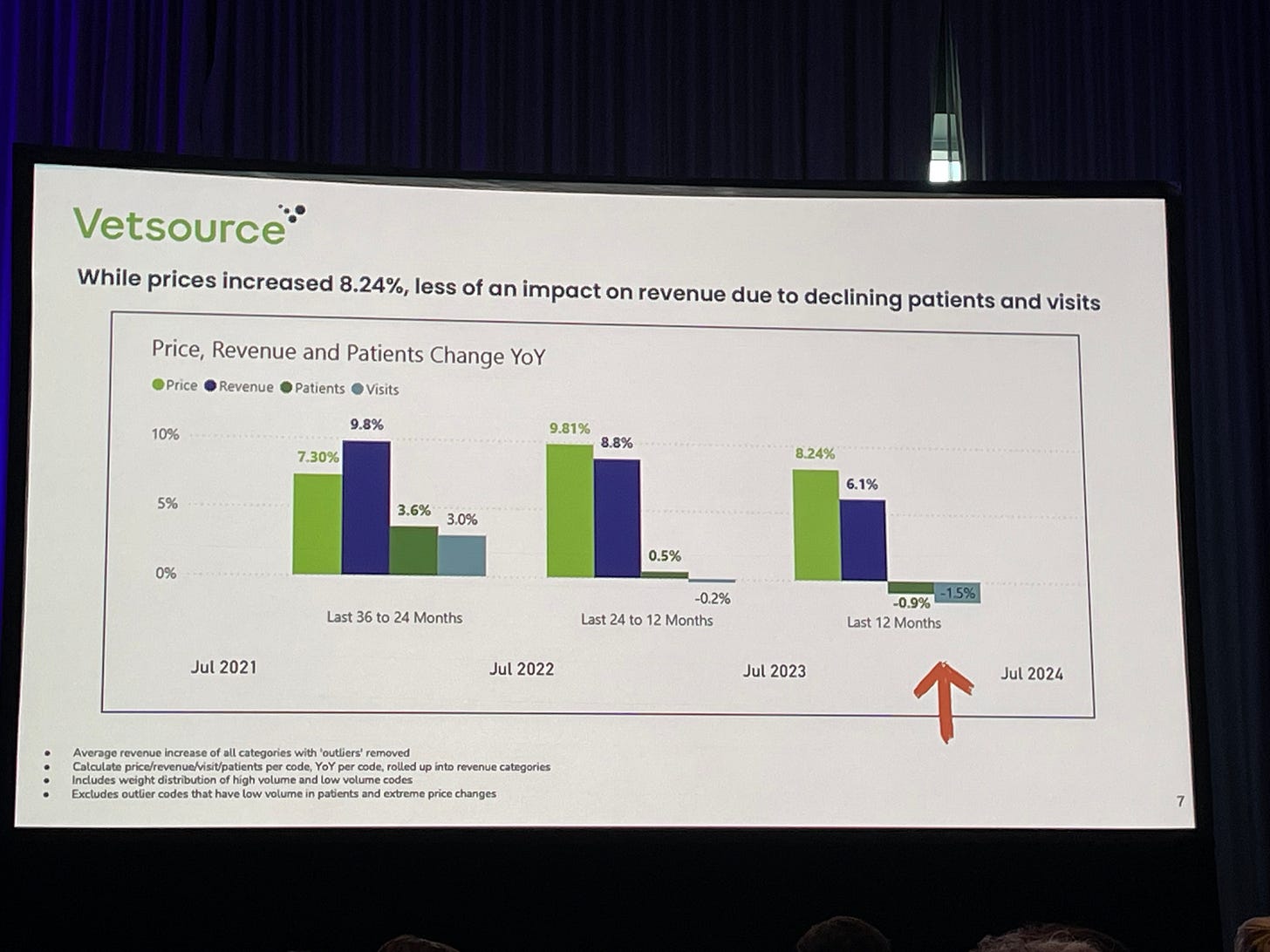Vet Innovation Summit 2024 Recap
Talking technology, start-ups, and economic headwinds in "KCMO"
Dear Readers,
Last week I had the privilege of speaking at the 2024 Veterinary Innovation Summit in Kansas City, Missouri (referred to as KCMO, pronounced “kay-cee-moe,” by locals to differentiate it from the part of the city within the state of Kansas, or KCK). It was my first time in this Midwest city and I had a great time networking and learning about new technologies. For those who were unable to attend, I thought it would be useful to provide a short recap of the conference highlights. Hope you enjoy reading about it as much as I did in person!
PS: As a bonus for paid subscribers, I have included a downloadable copy of my lecture on AI in medical imaging in PDF format at the end of the article.
—Eric
Keynotes on innovation, technology, and leadership
VIS 2024 featured a series of great keynote addresses by dynamic speakers from human medicine to the military and beyond. On Wednesday 8/21, David Zaboski, former Disney animator and current Chief Creative Officer of Laetro, captivated the audience with his talk on "Creativity and Innovation as a Technology," framing creativity as both a learnable skill and a systematic process involving collaboration, iteration, and risk-taking. He introduced the audience to the concept of “Plus’sing,” a Disney technique of building off ideas from others, which reminded me of the “Yes, and…” approach from improv comedy.
The following day, Indu Subaiya, MD delivered a keynote on the intersection of digital technology and healthcare, discussing the potential of telemedicine, the “hospital at home” model, and how the FHIR (Fast Healthcare Interoperability Resources) API standard enabled an explosion of secure, HIPAA-compliant apps and devices. She challenged the audience to consider whether veterinary medicine could surpass human medicine in certain areas due to fewer legacy IT systems and a consumer-driven market (rather than one dominated by third-party payment and regulations).

On Friday 8/23, Susannah Fox, former Chief Technology Officer for the U.S. Department of Health and Human Services and author of Rebel Health: A Field Guide to the Patient-led Revolution in Medical Care, highlighted the growing trend of patients using the internet to connect with each other (“peer-to-peer” healthcare) for support and advocacy. She highlighted historical examples of this “peer-to-peer” model such as the founding of Alcoholics Anonymous in the 1930s when addiction medicine didn’t exist, the Black Panthers tackling data collection for sickle cell anemia to drive research in the 1970s, and ACT-UP pushing for greater access to HIV treatments in the nineties. According to her, the core reason people seek out answers and support from each other: many patients suffer from health needs that are invisible and unmet, pushing them to consult Dr. Google, Facebook groups, forums like Reddit, and increasingly, AI chatbots. Educated professionals are not immune to this phenomenon: She sent a survey to VIS 2024 attendees before the meeting and the results showed…
8 in 10 said they went to Google first when confronted with a health issue
1 in 4 went online to connect with other patients who have similar issues
I have personal experience with these social media channels through both my experience with Graves’ Disease and my journey discovering I was donor conceived. Fox was frank about how these peer-to-peer patient networks could be both an reservoir of empathy and support as well as a vector of misinformation. However, rather than scoff at them, she suggested ways vets could validate pet owners who find good information and gently redirect people who find their way to unreliable sources.
The final keynote by Colonel Pilar McDermott, a leadership expert and retired U.S. Army officer, focused on “Leading with Grit and Character.” McDermott’s address was a powerful call for a culture where difficult conversations are not avoided but embraced. She framed her talk around a story of one of her own leadership failures where she did not reprimand one of the soldiers under her command for stealing because he was a high-performer who made her unit look good. One of her superiors took her aside and told her gently but firmly that she needed to do the right thing to model character for everyone else. Shortly thereafter she fired that soldier and found out that her refusal to enforce the rules was hurting morale and multiple subordinates even considered leaving over it. McDermott never made that mistake again and stresses how a culture of “nice” can be used to avoid accountability and lets problems fester. Her memorable line “culture is the worst behavior you are willing to tolerate” will stick with me for a long time.
Artificial intelligence intelligence dominates VIS 2024
One of the central themes of VIS 2024 was artificial intelligence. AI’s role in improving diagnostics, streamlining operations, and enhancing patient care was a focal point of discussions and presentations throughout the conference. According to data shared at the event, nearly 40% of veterinary professionals are already using AI tools, with two-thirds of these individuals incorporating AI into their workflows on a weekly or daily basis.
Speakers from the Mars data science team showed how their Whistle accelerometer product could detect itching in pets with allergies and monitor response to medication over time. They covered how they use machine learning AI to manage the large volumes of data generated by this device. Representatives from Companion showed how they use computer vision AI for training dogs.
Two of the three companies in the start-up pitch competition centered on AI, as did many of the exhibiting vendors. I was particularly impressed by the pitch for start-up Radimal*, which was co-founded by a veterinary radiologist, shows promising early data, and seems to be taking a veterinarian-centered approach to their tech and products, unlike some companies in this space.
* I don’t have any affiliation with this company and learned about them for the first time at this conference. My general comments do not imply an endorsement of their products/services.
I was part of a group of speakers and panels that took place over two days. On Thursday, Joe Mazzarella of Thrive Pet Healthcare provided high-level insights into how AI can be used in practices and Petra Harms spoke about the importance of AI literacy and creating best practices for ethical development. My lecture Friday morning focused on computer vision AI in radiology and pathology, with a focus on how the technology works, the potential benefits, and what the research says about current limitations. The centerpiece of my talk were real time demos of OpenAI’s GPT-4o interpreting (with varying degrees of accuracy) cytology images and walking the audience through a video of Harvard’s new pathology “co-pilot” tool PathChat. You could sense the awe—and worry—as I showed how eerily spot on the interpretations could be, as well as situations where the technology did a faceplant. Jonathan Lustgarten from Mars Veterinary Health lectured after me about IT considerations for implementing AI into large organizations.
The panel discussion afterwards featured myself, Jonathan, and Petra, and we had frank words about the need for skepticism and scrutiny of companies that aggressively push products without enough data. When asked how I would sum up my talk and advice to the industry in one sentence, my response was:
“Augmentation, not replacement”
Economic headwinds ahead
Not everything at VIS 2024 was sunny optimism. The final session was titled “What Do Today’s Trends Tell Us About Tomorrow’s Veterinary Medicine?” and multiple speakers talked about the macroeconomic headwinds that have been hurting veterinary practices over the last 12-18 months. Former AVMA Chief Economist Matthew Salois, PhD walked through data illustrating the slowdown in veterinary spending and close correlation with softening consumer spending across other industries. He predicted it would continue unless and until the US Federal Reserve began to relax interest rates, which have been weighing down consumer borrowing in an attempt to cool inflation. In a bigger picture philosophical section of his lecture, Salois talked about how current interest rates aside, veterinary medicine—and society in general—is facing a huge demographic shock and labor shortage caused not by too few schools, but by retiring baby boomers and declining birth rates in the developed world. In his view, the main way forward is adaptation and increasing efficiency through the use of technology.
Sheri Gilmartin from Vetsource continued with the reality check, sharing internal data that elaborated on Matthew Salois’s points. The slowdown in visits and declining revenue in the industry is not simply customers who are broke no longer going to the vet. Most people love their pets and still take them for sick visits, although they are stretching out the interval between wellness visits and increasingly picky about what products and services they agree to spend money on. There is a very simple reason for this: Over the last two years, veterinary companies in the US raised prices much faster than the rate of (already high) inflation. You can see in the figure below that raising prices is yielding diminishing returns as clinic visits decrease:
Clearly, we can’t rely on price increases to prop up growth forever. Perhaps we are belatedly discovering that veterinary medicine is not immune to the laws of supply and demand, and certainly not “recession proof” as folks claimed for decades. Hopefully the message from speakers like Matthew and Sheri percolate through vetmed and catalyzes a return to sanity.
The last speaker of the session and the conference was Mark Cushing. He is a lawyer and lobbyist most notorious for his role in the explosion of new vet schools, as well as pushing for a number of other controversial initiatives like the mid-level veterinary practitioner. He claims to be trying to help modernize the profession and fix the shortage of veterinarians. However, he admits that he has made a fortune in the process, often litigating for both sides at the same time! I’m not sure he actually believes in anything other than making money. It goes without saying that I wasn’t going to agree with his talk going in, but I wasn’t anticipating it to be so BAD. Cushing is older than I expected, and his voice was thin and reedy. He rambled and lost track of the points he was trying to make, sometimes contradicting himself. He half-bragged that he “didn’t let facts get in the way of a good argument.” Bizarrely, he spent most of the time talking about how he wanted to make veterinary medicine more “pet owner centered” instead of “veterinarian centered”—I could explain in more detail, but honestly the longer version doesn’t make any more sense—and that the upshot was we’d need less vets in the future! I texted a friend in the audience:
So, if I understand his argument correctly, it goes like this…
1. Here’s a million reasons we need to move away from needing so many vets
2. ????????
3. We need more vet schools!
Part of me honestly felt bad for him. Then I remembered he got rich through lobbying and undermining our profession. I would urge anyone sympathetic to his arguments to watch him lecture; it will quickly make you realize he’s just an old grifter.
The “BBQ Capital of the World”
On a final note, KCMO has multiple nicknames, and one of these is the “BBQ Capital of the World.” They aren’t joking! We ate some of the best brisket and ribs I’ve ever had that week, including at the local haunt Q39. I was introduced to the deliciousness that is “burnt ends,” the thin and flavorful points of brisket that develop a caramelized “bark” and are a staple of Kansas City-style barbecue.
VIS 2024 was only a few days long, but we packed in a ton of great conversations about the future of veterinary medicine, from inspiring keynote speakers to panel discussions on the responsible use of AI to catching up with some of my old friends and colleagues from Auburn, Lacuna, and IDEXX. That the food was great and the people were friendly made it even better. I would definitely recommend you attend VIS next year, and I hope to see you there!
PDF copy of “How Will AI Change Medical Imaging” after the pay-wall below 👇
Keep reading with a 7-day free trial
Subscribe to All Science Great & Small to keep reading this post and get 7 days of free access to the full post archives.











